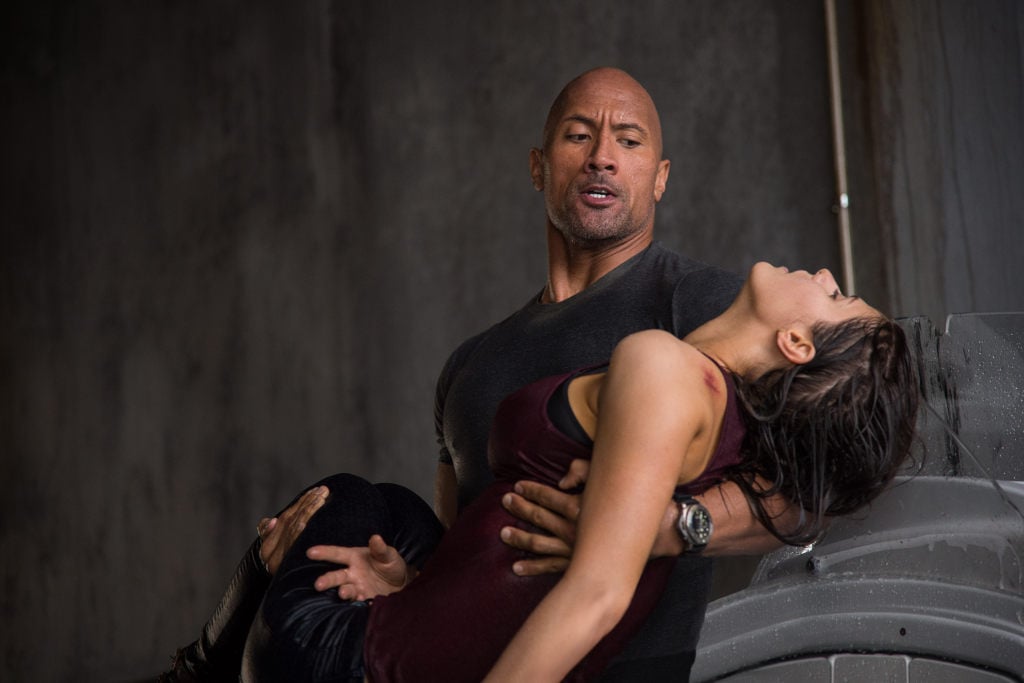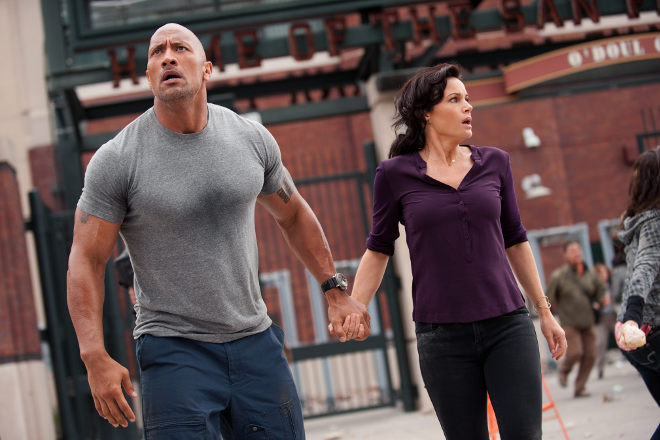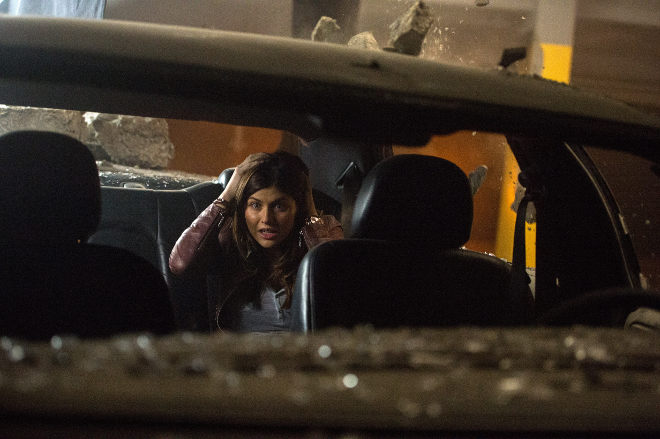Film Review: Not Even The Rock Can Save ‘San Andreas’
The problem with Hollywood megaquakes? 2 Vast. 2 Spurious.

Far be it from me to tell the National Aeronautics and Space Administration how to suck eggs, but after watching San Andreas, I’m wondering whether it’s time for another installment of NASA’s 2011 “dumbest science fiction movies” list.
Director Brad Peyton (last seen marshalling The Rock’s Journey 2: The Mysterious Island “pec pop” in glorious 3D) claims to have consulted with seismologists in the lead-up to the film’s release, but watching the The Core-level Movie Science on display, one wonders if “consulted” means “scrunched up their notes and called them ‘Poindexter’ before flushing their head in the toilet and laughing uproariously”.
This is the sort of film in which the seismologist (Paul Giamatti, apparently suffering from terrible jet-lag) has to scribble a lot on maps of California about a “swarm” of earthquakes that’s travelling up the San Andreas fault, and talks often about how we need to pray for the people of San Francisco.
And, of course, when asked who needs to be called about the string of megaquakes about to hit SF, he replies: “Everyone.” DISASTER MOVIE BINGO!
More on the science later though, because in truth, the real moment San Andreas catapulted me out of my suspension of disbelief was when Emma (Carla Gugino) serves heroic L.A.F.D. rescue pilot Ray (Dwayne “The Rock” Johnson) with divorce papers. They expect us to believe that somebody would divorce The Rock?! I’m outta here!
The Human Cost
Peyton has taken the Roland Emmerich route in bringing San Andreas to the screen, zeroing in on one family’s experience of the disaster. That means that Ray and Emma must temporarily reconcile as they attempt to rescue their daughter Blake (Alexandra Daddario), who is stranded in San Francisco with Emma’s toffy new boyfriend Daniel (Ioan Gruffudd), a Trump-esque building magnate.
When the first Big One hits, Ray swoops in to pluck Emma from the rooftop of a crumbling hotel in downtown L.A (take that, gentrification!), upon which they set off for San Francisco. Poor SF only just rebuilt after that pesky problem with the giant lizard and the radioactive moths — and now this?
There are added Stakes™ because Ray and Emma have already lost one daughter (this fact is announced with hysterical bluntness by Kylie Minogue in a small role) and they Don’t Want To Lose Another. You could set your watch by this shit.
Meanwhile, Blake is thrown together with a pair of nondescript English brothers, Ben (Hugo Johnstone-Burt) and Ollie (Art Parkinson), who are visiting SF on holiday. If only they had a San Francisco guide book that lists all the stores where you can buy an analog phone to contact your rescue pilot dad — ah here’s one!
The meat in this disaster sandwich is Giamatti’s “Lawrence” (evidently the Beyonce or Cher of seismology), who scurries around Caltech with his students providing “As you know, Bob…” nuggets of exposition in between big VFX shots. The recurring theme in the film is one of ordinary Americans banding together to Get Through This.
The Slovenian philosopher and cultural critic Slavoj Žižek has spoken at length about the utopian subtext of disaster movies. “What fascinates me about disaster films is how circumstances of vast catastrophe suddenly bring about social cooperation,” he said in 2003, in the immediate cinematic aftermath of 9/11. “Even racial tensions vanish. Disaster films might be the only optimistic social genre that remains today, and that’s a sad reflection of our desperate state. The only way to imagine a Utopia of social cooperation is to conjure a situation of absolute catastrophe.”
As the valiant hero, Johnson is his usual charming self; everybody else at least punches their card. That’s about all you need to know about the human side of San Andreas because, let’s be real, folks, you don’t go and see a film of this nature for the touching family reunions.
You go to see shit get wrecked.
Hollywood Megaquakes: 2 Vast 2 Spurious
Shot in part around Brisbane and the Gold Coast, the movie mostly does a bang-up job of disguising Queensland as California (except for one presumably accidental crane shot, in fake-Bakersfield, of noted Northern Cali chain store, Ray’s Outdoors). There are a couple of nice shots, including one of a BART hurtling out of its tunnel and another of a naval vessel wedged between two skyscrapers, seemingly lifted straight from the concept art, but the real order of business here is destruction.
A short list of things destroyed in San Andreas includes the Hoover Dam, most of downtown L.A, some fields outside Bakersfield, almost all of San Francisco, and a fair bit of rational thought.
The filmmakers have apparently ignored the intel that, were a major quake to happen in Los Angeles, it would likely be due to the horizontal Puente Hills fault; the San Andreas fault is, in fact, 30 miles from downtown, on the other side of the San Gabriel Mountains. A “worst case scenario” M ≥ 8.0 Puente Hills quake (which happens roughly every 2500 years) would, according to USGS and Southern California Earthquake Center, kill up to 18,000 people and cause $251 billion in damage, much of it to DTLA.
In fact (something in short supply in San Andreas), the eponymous fault is unlikely to be able to produce a megaquake of the big screen variety due to the specifics of its geology; however, if a “Big One” were to occur, the bulk of the damage would likely be centred around Palm Springs (RIP Ace Hotel).
I know about all this because I lived in L.A for two years, and would pray every night that the ceiling fan didn’t come down on me, along with the other four storeys in my apartment building.
Let’s say a San Andreas quake did affect the city, though. A Los Angeles Times study back in 2013 found that there were a great number of concrete buildings in L.A that were vulnerable to quake activity. Many of them are centred around Hollywood/Vine, which would surely have been a much more visually dynamic disaster than the generic downtown hotels San Andreas has gone for — but perhaps too real a metaphor for the end of ideas in Hollywood, come to think of it.
Götterdämmerung: Destruction Business As Usual
ANYWAY, if you’ve come not for science but to see high rise buildings shudder into showers of broken glass and masonite in 3D, then you’ve come to the right place. San Andreas brings you bang-up-to-date effects and lulls you into a bloodthirsty disaster frenzy; you may even find yourself disappointed when the seismic activity starts to cool off.
And this is where we find ourselves, inured to the emotional impact of big-screen catastrophe by repeat exposure, in 2015: why stop at two earthquakes and a tsunami? Why not chuck in an electrical storm or a few big fires, too? Why don’t we get to see more people literally swallowed alive by the earth’s gaping maw?
Much was made of whether or not Warner Bros should delay the release of the film, given the recent deadly earthquakes in Nepal; there’s a couple of blink-and-you’ll-miss-it earthquake safety info lines listed in the end credits, the seismological equivalent of tacking on the LifeLine number.
Step back for a moment in the midst of San Andreas, and you may start to think a little too deeply about how many dead bodies must be floating in the water that The Rock’s speedboat is soaring across. Don’t worry, though, an American flag unfurling in slow-motion will appear soon enough, and no good looking people die. A sad reflection of our desperate state, indeed.
–
San Andreas opens around Australia tomorrow.
–
Clem Bastow is an award-winning writer and critic with a focus on popular culture, gender politics, mental health, and weird internet humour. She’s on Twitter at @clembastow

